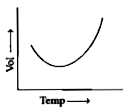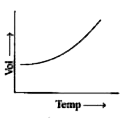What is the physical state of water at-
(a) 25∘ (b) 0∘C (c) 100∘C?
To determine the physical state of water at different temperatures, we can analyze the conditions at each specified temperature:
1. At 25°C:
- Water is in its liquid state. This is because 25°C is above the freezing point (0°C) and below the boiling point (100°C) of water.
- Therefore, at this temperature, water is commonly used for various daily activities such as drinking, cooking, and washing.
2. At 0°C:
- Water exists in its solid state, known as ice. This is the freezing point of water, where liquid water begins to solidify.
- For instance, if you place water in an ice cube tray and freeze it, the water will turn into ice at this temperature.
3. At 100°C:
- Water is in its gaseous state, known as water vapor. This is the boiling point of water, where it starts to evaporate.
- When you boil water, you will notice steam or vapor rising from the surface, indicating that the water has transitioned from liquid to gas.
Summary of Physical States:
- (a) At 25°C: Liquid
- (b) At 0°C: Solid (Ice)
- (c) At 100°C: Gas (Water Vapor)
- Water is in its liquid state. This is because 25°C is above the freezing point (0°C) and below the boiling point (100°C) of water.
- Therefore, at this temperature, water is commonly used for various daily activities such as drinking, cooking, and washing.
- Water exists in its solid state, known as ice. This is the freezing point of water, where liquid water begins to solidify.
- For instance, if you place water in an ice cube tray and freeze it, the water will turn into ice at this temperature.
- Water is in its gaseous state, known as water vapor. This is the boiling point of water, where it starts to evaporate.
- When you boil water, you will notice steam or vapor rising from the surface, indicating that the water has transitioned from liquid to gas.
- (a) At 25°C: Liquid
- (b) At 0°C: Solid (Ice)
- (c) At 100°C: Gas (Water Vapor)
Topper's Solved these Questions
Similar Questions
Knowledge Check
- Question 1 - Select One
The relation between volume and temperature of a sample of water in the range 0∘C to 100∘C is best represented by
A B
B C
C D
D
Will the pH of water be same at 4∘C and 25∘C ? Explain.
View SolutionWhat is the free energy change, 'ΔG' When 1.0 mole of water at 100∘C and 1 atm pressure is converted into steam at 100∘C and 1 atm pressure
View SolutionIn a ABC, if AB=AC and BC is produced to D such that ∠ACD=1000, then ∠A=
(a) 200 (b) 400 (c) 600 (d) 800View SolutionWhat is the distance between the points A(c, 0) and B(0, −c) ?
View SolutionThe vapour pressure of pure water at 25∘C is 23.00 torr. What is the vapour pressure of 100gof water to which 100g of C6H12O6 (glucose) has been added ?
View SolutionIn a ABC, ∠A=500and BC is produced to a point D. If the bisectors of ∠ABC and ∠ACD meet at E, then ∠E= (a)250 (b) 500 (c) 1000 (d) 750
View SolutionIn a steady state of thermal conduction, temperature of the ends A and B of a 20 cm long rod are 100∘C and 0∘C respectively. What will be the temperature of the rod at a point at a distance of 9 cm from the end A of the rod
View Solution
